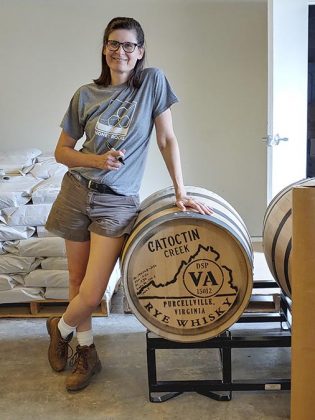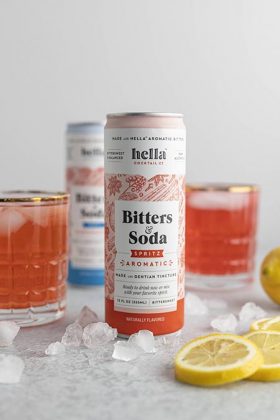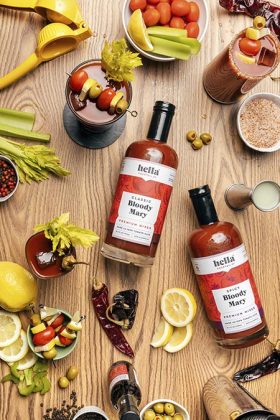The year is 2019. It’s late June in New York City, and monied Manhattanites can be heard planning their seasonal escape to the Hamptons or other such places of well-to-do frolic as they sip their lattes in the Upper West Side. The chatter on the Javvits Center’s floor during the 65th annual Summer Fancy Food Show forms a different tale, one seemingly carrying a worrisome timbre for anyone in the craft distilling industry: The sober curious movement is coming, and it’s going to cut into your profits. It wasn’t a message trumpeted outright by the brands seemingly occupying every fifth kiosk space, but the overwhelming presence of zero-proof brands provides enough confirmation bias to 2019’s seemingly endless cavalcade of sober curious-themed journalistic think-pieces to think that maybe, just maybe, the distilling industry would experience some level of decline, anywhere from a financial boop on the nose to full-blown existential dread.
A lot has changed since then. COVID-19’s chaotic evil took care of the existential dread part, and likely induced longing for a time when death by a thousand mocktails seemed like a plausible concern. It’s also caused a weird sense of amplitude within the sober curious ranks. The movement’s media-fueled zeitgeist is long gone, shoved to the shadows over breathless reports of Americans drinking way too much booze at home during these bizarre pandemic times. Yet as weeks of lockdown turn into months and more people realize drinking martinis during their 10:00 AM Zoom meeting is probably a bad look, the no- and low-alcohol movement appears to be making a smarter, more understated comeback.
“We may be at the point where people need to ‘soften the edges’ and take a step back from drinking,” said Laura Menz, co-founder of the Los Angeles-based natural drink mixer company Muddle & Wilde. “At the same time, we know these patterns of drinking and taking a break tend to go in circles.” Menz’ acknowledgement of ebb and flow strikes the core of the sober curious movement’s evolution. At the height of its powers in 2019, the movement’s most sensationalized areas tended to inadvertently assume those interested in no- and low-alcohol beverages were diving headlong into the teetotaler lifestyle. That’s not the case anymore. It really wasn’t the case during “dry January,” at least from a marketing and trend perspective. The Winter Fancy Food Show was held in mid-January in San Francisco’s Moscone Center and presented a fraction of zero-proof kiosks compared its summertime cousin just seven months prior. The brands that were there emphasized a better understanding of the consumer market that ultimately re-set the movement’s course. It’s an understanding that they’ve carried through the pandemic’s dark days. “The word ‘curious’ is in the phrase ‘sober curious’ for a reason,” explained Ben Inadomi, sales manager for True Brands, a beverage and lifestyle accessory wholesaler in Seattle, WA. “People have been stuck at home for a while, so they may be seeking out things to satisfy their curiosity. If they usually drink at home, they may feel that this might be a great time to experiment a little with no- and low-alcohol beverages.”
The companies leading the charge on this evolving viewpoint also tend to come from a place of craft, either directly through their own products or through the brands they promote. Their stance is a case of game recognizing game; craft producers of non-alcoholic mixers, sodas, and beverages respecting the artistry behind craft and small-batch distilling. It’s an admiration they want to extend through a symbiotic relationship with craft distillers, one that intersects at the consumer’s home bar cart. “If you care about what you’re drinking, you’re not going to mix craft spirits with a crappy mixer, and vice versa,” explains Eddie Simeon, co-founder of Long Island, NY-based Hella Cocktail Co. “I wouldn’t want to, so I can’t assume our customers wouldn’t feel the same way.”
Playing Both Sides
One of the highlighted products on True Brands’ website these days is a drinking game called Warshots. Released during the pandemic, the board’s Battleship-esque layout is instantly familiar, but the submarines and aircraft carriers prominent in the Milton Bradley classic aren’t anywhere to be found. In their place are flat game pieces with holes to place shot glasses. If your target’s hit, you take the shot. Losing provides true victory. It’s a board game for our times — at least, our current times. “We got lucky on that one,” explained Inadomi. “It was something we had in the works before the pandemic, but it’s release ended up being well-timed.”
Warshots also highlights the underlying pattern that exists within the business side of the sober curious landscape. Plenty of brands attached to the movement are adept at playing both sides. True Brands’ adult board game and bevy of cocktail liquids and ephemera share portfolio space with cans of artisanal high-end teas. Muddle & Wilde promotes the usage of their juice for natural, family-friendly sodas with the same energy they exert for cocktails. Hella’s aggressive push of zero-proof drinking through their grapefruit, lemon lime, and ginger turmeric sodas balances the promotion of their bitters and cocktail mixers. It’s a holistic approach that honors the concept of the complete drinker, the soul that casually rotates sober evenings into an imbibing schedule that may or may not include boozy riffs on family game night. Exactly how they’re being enjoyed remains a mystery, since so many of these products can freely bounce back and forth between the alcoholic and non-alcoholic landscape. “It’s tricky for us to know for sure, but we have had some of our customers share what they’ve done,” said Moira Gilbert, Muddle & Wilde’s co-founder and CEO. “Some people have told us that they’ve bought our products for cocktails, full stop. Others have emailed us to say they’ve had non-alcoholic ‘Muddle & Wilde’ nights at home. That’s incredibly gratifying to hear.”
Then again, their usage doesn’t matter if they’re being bought. Sales of quaffable cocktails peripheries like mixers and sodas haven’t enjoyed the fanfare reserved for alcohol sales — not surprising, since reports of boosted booze purchasing have been rehashed like breakfast leftovers almost weekly. Yet they’ve been nonetheless robust. “Business is pretty darn good, all things considered,” said Gilbert. “We’ve increased our retail presence in places like Whole Foods, and we’ve seen increased sales during the pandemic, even though we can’t do things like we would normally do, like in-store demos.” These successes are worth celebrating, but they are in no way taken for granted. “When the pandemic started, we had no idea how it would affect our logistics and supply chain leading up to retail,” Simeon said. “We look back now, at how little information there was to work with in the beginning, and we feel lucky we were in a position to make our pandemic pivot happen so smoothly.”
The Distillers’ Point of View
So, what does the distilling industry make of all the movement on the sober curious side of things? Frankly, not a whole lot. When asked about it, the tendency is to point to brands like Seedlip and acknowledge no- and low-alcohol drinking will be around for a long time. “The big portfolios have a stake now,” said Kara King, Communications Director at Ironclad Distilling in Newport News, Virginia. “There are too many people involved that don’t want to see sober curious collapse.”
The industry’s shoulder-shrugging position toward sober curious is justifiable. After all, they’re concerned with issues far more serious than a handful of customers deciding to lay off the sauce for a couple of weeks. One of the key areas of focus involves keeping the current Federal excise tax reduction intact beyond its slated December 31, 2020 expiration date, a lapse that will yield a whopping 400% tax increase for craft distillers if it occurs. “If the Federal Excise Tax jumps up, that $2.70 proof gallon rate the small distilleries are paying now is going to jump to $13.50,” said Becky Harris, Co-Founder and Chief Distiller at Catoctin Creek Distillery in Purcellville, Virginia and President for the American Craft Spirits Association (ASCA). “The little guys can’t do business that way at those costs, especially when they’re already struggling.”
“If they don’t keep the excise tax in place, it will hurt small distilleries worse than the pandemic,” stated King. “It will hurt the whole industry. The small guys that would get devastated the most are oftentimes the ones that are moving the industry forward. They need to be protected.”
Distillers are also pushing toward change in direct-to-consumer laws, from seeking permanency in temporary intrastate DTC laws to developing interstate DTC distribution. “Setting up these laws has to be done very carefully,” Harris said. “It’s got to be done on a state-by-state basis, which makes it a long process, but it can be done.” While Harris and others in the industry patiently beat this DTC drum around the country, the lax response generated in some states makes it tough to be methodical. “It’s been crickets from our state government so far, which is frustrating,” said Gabe Richards, Stillhouse Manager for Balcones Distilling in Waco, TX. “It’s important that something happens soon. It would suck to see the room thin out because the smaller distilleries can’t get their product to consumers or some B.S. like that.”
Looking Forward
When this pandemic mess is over, how are we going to react?
History informs that booze will be involved. The hell that was the Spanish Flu of 1918-19 gave way to The Roaring ‘20s. Prohibition blanketed that halcyon era, and people still found ways to party (not to mention create legendary cocktails like the Bee’s Knees and the Sidecar). While the sober curious movement in whatever form it takes on the other side of COVID-19 will also be part of proceedings, it won’t come close to resembling the Noble Experiment’s nasty scourge. In fact, its presence may not be all that terrible. “I know of a few people that are already trying to do ‘dry week’ once a month, and that’s fine,” Richards said. “The last thing you want to do is to turn something that’s a great hobby into a liability.”
“The reaction’s going to vary person to person,” Simeon said. “A person smarter than me once said that modern consumer has their own drink portfolio. People that already drink will keep drinking after the pandemic, but they may explore the lower end of the ABV spectrum now and again when they feel the time is right. All we can do is be prepared to meet wherever our customers are at on their drinking and cocktail journey.”
It may be some time before we get to this point. Until then, drink up. The liquor you use is up to you — that is, if you choose to use any liquor at all.












